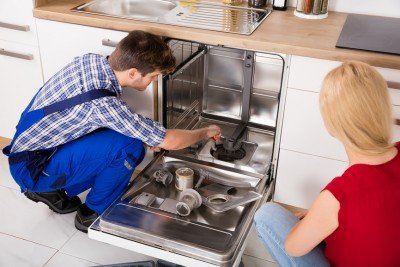My Dishwasher Will Not Drain?
If the dishwasher still won’t drain, a bad solenoid may be causing the problem. In this case, even if the drain pump is running, the drain pump will not effectively drain the dishwasher. Checking the other end of the hose will most likely require access to the drain pump inside the dishwasher. To check for blockages in the drain or pump, remove the filter to expose the drain and pump at the bottom of the dishwasher.
After turning off the water and turning on the dishwasher, check that the drain hose is not kinked or clogged. Water at the bottom of the dishwasher is the result of a clogged filter, waste disposal system, drain hose, drain pump, or air gap. Sometimes a Frigidaire dishwasher that won’t drain is due to an air gap or clogged drain, not the dishwasher. In some cases, when the dishwasher does not drain water, the cause may be an air gap or drain pipes.
Complete waste disposal or an air gap in the connecting hose may prevent the dishwasher from draining properly. If the drain hose is kinked or clogged, it can prevent water from flowing out, leaving a puddle in the dishwasher. Remember that if the drain pipe or sink drain hose is clogged, draining the sink will cause water to return to the dishwasher if you don’t have an air gap. Over time, the dishwasher filter itself can become clogged with debris and block the water drain.
If one of them becomes clogged with debris, it could block the drain, causing water to return to the dishwasher during the wash cycle. If one of them is clogged, the water could get clogged when draining the dishwasher, causing leaks or even leaks. When this happens, the water doesn’t drain properly, causing the dishwasher to back up.
If the dishwasher won’t drain, a clogged drain is a common cause. When food or sediment builds up inside the filter’s blockage, the dishwasher won’t drain properly. If your dishwasher gets your dishes wet with a puddle of dirty water, the filter may be clogged. If you’ve ever turned on the dishwasher and found dirty water under the bottom basket, you’ve had a drainage problem.
Before checking dishwasher components that may be causing the problem, make sure the hose into which the GE dishwasher drains is not clogged. If the dishwasher accidentally turns off during a cycle, there will be water on the bottom when you open it. If the dishwasher drain hose is kinked or clogged with debris, this can restrict the flow of water and you will notice water remaining in the dishwasher at the end of the cycle. Over time, the drain valve can become clogged with debris and not open, causing water to remain in the dishwasher.
If the drain valve is clean but still not working, it needs to be replaced. The valve can also become clogged with debris, preventing it from opening and closing properly. The drain hose connected to the pump can also be clogged, which can be removed by simply disconnecting the drain hose from the dishwasher pump and blowing it out after turning the dishwasher off.
These blockages usually appear in the hose that connects to the drain pump or dishwasher and can be removed to fix drainage problems. To check for a blockage, you need to remove the bottom front panel and find where the finned tube connects to the dishwasher drain pump. If there is excess water in the pump, you may need to sponge it dry before checking for a blockage.
If the dishwasher still appears to be clogged, check the kitchen sink drain. If both the trash can and kitchen sink drain are draining properly, and there is water in the bottom of the dishwasher, the filter is clogged, the drain pump impeller is clogged, or the drain hose is clogged/kinked. If all is well and your dishes are being washed, a small amount of standing water in the dishwasher is normal and probably nothing to worry about. While standing water can indicate that your dishwasher needs professional repair, it’s usually a small problem that you can fix on your own.
It is normal for some water to remain in the dishwasher after a cycle to prevent the dishwasher seals from drying out. The drain hose is a lightweight plastic hose that connects the dishwasher to a sink drain or waste bin so that water can drain. When a dishwasher hose is connected to a sink without a waste chute, an air gap—a small, grooved cylinder (often made of stainless steel)—is installed on top of the sink, right next to the faucet.
If the bin is clogged with debris, the water in the dishwasher will not drain properly and may return to the dishwasher during the wash. If you run the dishwasher with the chute clogged with food debris, the water won’t be able to get to the same drain.
Over time, things like grease will affect the system, causing the drain hose to clog and therefore prevent the dishwasher from draining. If the dishwasher won’t drain, or if too much water remains at the end of the cycle, it may be because food particles are clogging the bowl area, or it may be caused by a clogged dishwasher drain hose or a faulty part such as a motor or drain pump. In some cases, you may be dealing with a clogged main exhaust chimney or even a sewer line, but this will affect all drains in your home.
If you can’t find the cause of the dishwasher problems then call for dishwasher repair in Oklahoma City and be sure and contact Appliance Repair OKC Services by calling 405-378-4566 or visit our local website at https://www.okcappliance.com or also our Google business website at https://cli.re/Dyq1ME. Call now!

